All around the world, cranes have played a dominant role in helping with the task of lifting and transporting heavy payloads. They are used in many different places such as shipyards, construction sites, and industrial workplaces.
Today, many different crane types exist, each type is specifically designed for the environment in which it is being used. One of the more common crane types is the tower crane.
The tower crane is mainly used on construction sites and has proven its usefulness in the construction of very tall buildings. This type of crane has a small footprint but is still able to cover a very wide working area.
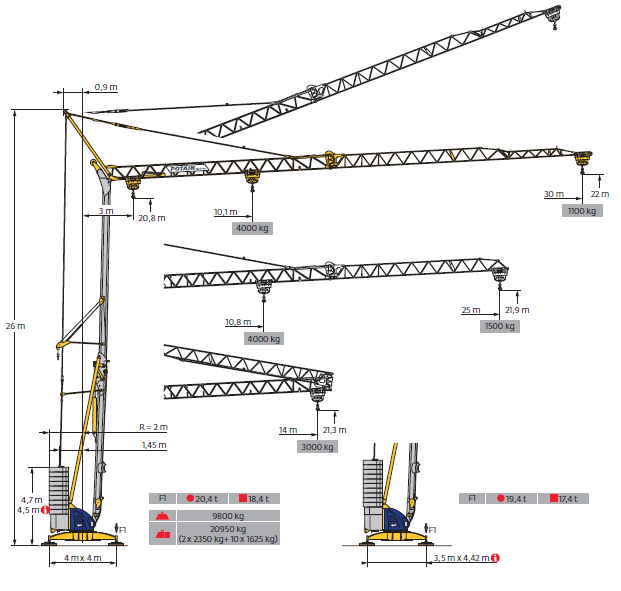
Tower crane lifting
The lifting capacity of Tower crane depends on various factors.
The limitation for lifting weight starts from the base of the tower crane. Each and every component of the tower crane affects the load lifting capacity of the tower crane.
For a typical tower crane Maximum unsupported height – 80 meters (265 feet) Maximum Reach – 70 meters (230 feet), Maximum Lifting Power – 19.8 tons (18 Metric Tons), 300 tonne-meters. Counterweights – 20 tons (16.3 Metric Tons).
If the crane height is more than 265 feet, then some means of sturdy support is required. It may be some steel wires fixed from the crane mast to the different parts of the building. The maximum weight that the tower crane can lift is 18 Metric Tons. However the quantity of weight to be lifted keeps on decreasing as the distance from crane center increases. So it is always better to lift loads keeping them as close as possible to the crane’s center.
The factor 300 tonne-meter is instrumental in understanding the load limitation. It is the moment of the load lifted about the crane’s center. So moment = load * distance.
A 300 tonne-meter limit can be inferred as a load of 10 tons being lifted at a distance of 30 meters from the center of the crane. So moment about the crane’s center is 10 tons * 30 meters = 300 tonne-meter.
Tower crane load capacity
Basic precautions for a Tower Crane with respect to a load being lifted:
- Maximum load limit switch: This switch along with its accessories monitors the pull (strain) on the cable and thus does not allow the maximum load limit to cross 18 tons, after which it trips the motor and gives audible and visual alarms.
- Load moment limit switch: This limit switch along with its accessories ensures the load-moment (tonne-meter) rating does not exceed beyond the given limit, after which the hoist motor and traversing motors are tripped with audible and visual alarms.
- These towers are held at the base by concrete structures/pads, with the help of anchor bolts. These concrete slabs are made ready several weeks before the arrival of the tower cranes. These concrete pads weigh about 2 tons.
Tower crane capacity
Each crane has a load chart that, in short, specifies the crane’s capabilities detailing its features and how its lift capacity varies when considering distance and angle. Just like the old saying ‘if you fail to plan, you plan to fail,’ failing to consult a crane load chart before renting or employing a crane for a specific job could leave you with too much or too little capacity for your job.
Before a crane is rented, transported, employed or purchased, the crane chart must be consulted. Everyone, from the crane operator to the job supervisors, to even the sales guys have to know how to read a crane chart. Here’s how.
To illustrate how to read a crane chart, we’ve chosen the chart for the Terex RT345XL, a rough terrain crane with a maximum lift capacity of 45 tons.
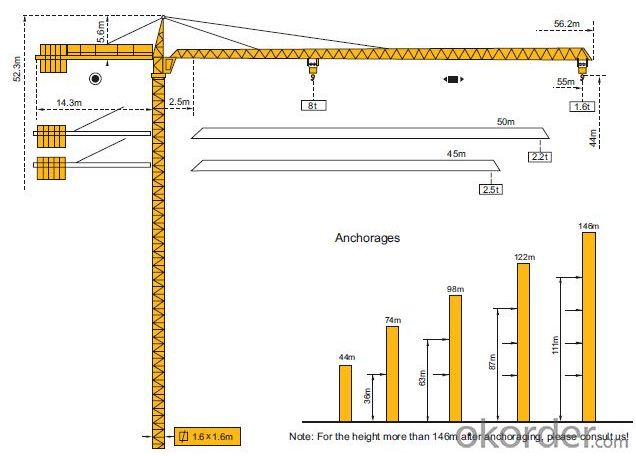
Tower crane lifting capacity
To illustrate how to read a crane chart, we’ve chosen the chart for the Terex RT345XL, a rough terrain crane with a maximum lift capacity of 45 tons.
Tower crane weight
The chart shows the crane dimensions. It includes data for operation with the outriggers extended, transport weight, and steering dimensions. Knowledge of this information is especially critical if the crane will be working in a confined space, as the lifting capacity varies depending on whether the outriggers are extended.
The transport weight (below) determines the trailer to be used, how to load the crane on the trailer, the route to take, and what permits are required to get it to the job site. Along the top axis, the first number is the gross vehicle weight. In the other two columns, the arrows indicate the weight load for each axle depending on what additional accessories are loaded.
Crane lifting capacity
This is where the magic happens. In the legend at the top of the chart, you can see these ratings apply when using 6.5 tons of counterweight, with the outriggers extended to 22 x 22.3 feet. Here, you’d graph out the specific lift the crane is needed for. The ‘ft.’ indicator on the left axis represents the radius, the distance from the center pin to the center of the load.
EXAMPLE: You need to lift a load of 15 tons (30,000 pounds) a distance of 25 feet. The distance is measured from the center pin of the crane to the center of the load. Once you determine the distance, look on that line for the largest capacity; that will indicate how many feet of boom must be extended. In this case, it is 45 feet.
It’s important to note that the maximum capacity is always measured by the shortest lift, usually over the rear of the crane, and with the outriggers fully extended. While the Terex RT345 has a maximum capacity of 45 tons, lifts at any distance or height drop the maximum capacity dramatically.
Tower crane boom length
Lift range: Just as important as lift capacity is lift range. For that, a range diagram is usually included in every chart which illustrates how much boom length is needed to pick up and lift a load both at a distance and at height.
EXAMPLE: You need to pick up a load at 25 feet and lift it to the top of a five-story, 65-foot building. Consulting the range diagram, 69 feet of boom is required to make the lift.
Tower crane lifting plan
Lift angle: This chart illustrates the maximum lift if a luffing or fixed jib is used. Lifts with jib lengths of 32 and 49 feet (in addition to boom extension of 105 feet) are illustrated. With higher angles of lift, the maximum load capacity decreases. With a luffing jib, the angle can be automatically adjusted from the operator’s cab. With a fixed jib, of course, the angle is fixed.
Slewing motor tower crane
Tower crane in motion: This illustrates the lift capacity for a pick and carry. Here, the chart illustrates the total weight able to be picked up at a 360-degree angle while stationary on wheels, the total weight being able to be supported both while slowly rolling with the load at a zero degree angle (creep), and the total weight able to be supported while moving at 2.5 miles per hour. The column to the left again indicates the radius of the lift, the one to the far right, the maximum boom length each weight can be carried at.
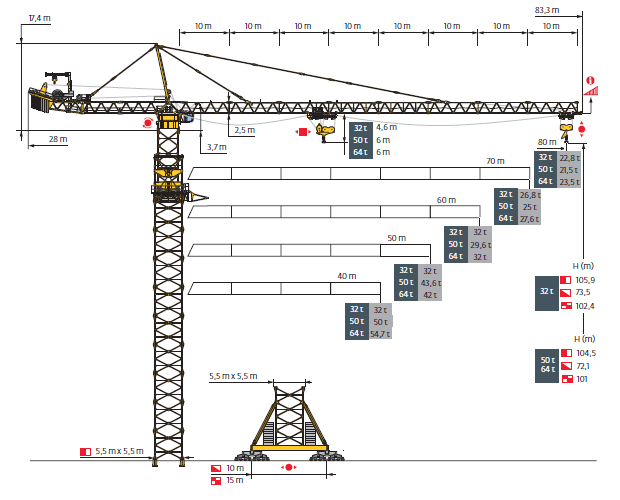
How to calculate crane load capacity?
How to use load charts:
- Crane Institute of America:
- Using load charts correctly is considered the single most important aspect of safe crane operation.
- Step by step, this guide explains how to determine the lifting capacity of a crane.
- Areas of operation, load radius, gross and net capacity, parts of the line, and other common technical terms are also defined and illustrated.
Safety load capacity
Companion item to “Professional Crane Operator Instructor Guide” and Professional Crane Operator Participants Guide”
How does a tower crane balance?
Basically, a tower crane has a large load on the other side of the crane. It keeps it balanced like a scale. On other tower cranes, they use cables that relay the force of the lifting to other parts of the crane near the ground, again, providing a counterforce for the weight of the load it is lifting.
Incorrect ballast will cause a crane to fall over. The base of the crane is bolted into the ground and weighed down by giant blocks of concrete. The stiffness of the supporting structure also helps counteract bending caused by unbalanced loads.
The maximum load that the crane can lift is 18 metric tons (39,690 pounds), but the crane cannot lift that much weight if the load is positioned at the end of the jib. The closer the load is positioned to the mast, the more weight the crane can lift safely. The 300 tonne-meter rating tells you the relationship.
Tower cranes are widely used for lifting operations in the construction industry. Statistics show that tower cranes contribute to quite a number of serious accidents. Property damage and bodily injuries can be avoided if they are properly used.
The three most common hazards involving tower cranes include electrical hazards, overloading, and materials falling/slipping from overhead hoists.
The most read
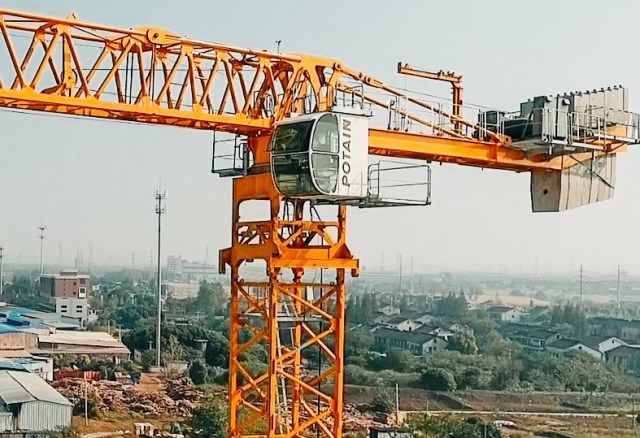
Tower Crane Boom Length
The boom length of each tower crane determines its maximum capacity.
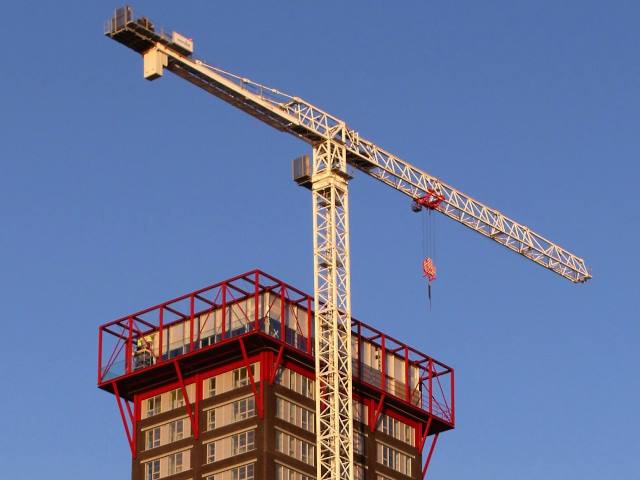
What is the Tip Load of Tower Crane
This value is crucial for crane operators and site planners as it directly influences the crane lifting capacity and the safety of operations.
